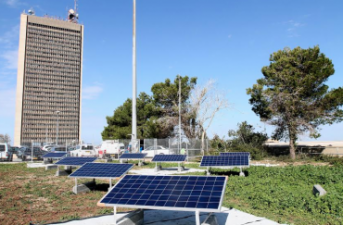 Can Mr. Potatohead outrun the Energizer Bunny? Researchers in Israel and California develop a potato battery, 50 times cheaper than the Energizer equivalent.
Can Mr. Potatohead outrun the Energizer Bunny? Researchers in Israel and California develop a potato battery, 50 times cheaper than the Energizer equivalent.
Here’s one for potato lovers: the Hebrew University in Jerusalem has developed a solid organic electric battery that uses potatoes for energy. The simple, sustainable device, they say in a press announcement, could provide an immediate electricity solution in off-grid locations in the developing world.
Scientific backing for the invention was published in this month’s issue of the Journal of Renewable and Sustainable Energy: “The ability to provide electrical power with such simple and natural means could benefit millions of people in the developing word, literally bringing light and telecommunication to their life in areas currently lacking electrical infrastructure,” said Yaacov Michlin, CEO of Yissum, the University’s tech transfer arm.
How it works:
Researchers discovered that the enhanced salt bridge capability of treated potato tubers can generate electricity through means readily available in the developing world. This cheap, easy to use green power source could substantially improve the quality of life of 1.6 billion people, comprising 32% of the developing non-OECD populations, currently lacking access to electrical infrastructure.
Such a source can provide important needs, such as lighting, telecommunication, and information transfer.
In their research, they discovered a new way to construct an efficient battery using zinc and copper electrodes and a slice of your every day potato. The scientists discovered that the simple action of boiling the potato prior to use in electrolysis, increases electric power up to 10 fold over the untreated potato and enables the battery to work for days and even weeks.
The scientific basis of the finding is related to the reduction in the internal salt bridge resistance of the potato battery, which is exactly how engineers are trying to optimize the performance of conventional batteries. The ability to produce and utilize low power electricity was demonstrated by LEDs powered by treated potato batteries.
Cost analyses showed that the treated potato battery generates energy, which is five to 50 folds cheaper than commercially available 1.5 Volt D cells and Energizer E91 cells, respectively.
The clean light powered by this green battery is also at least 6 times more economical than kerosene lamps often used in the developing world.
This means that the boiled potato or other similarly treated vegetables could provide an immediate, environmental friendly and inexpensive solution to many of the low power energy needs in areas of the world lacking access to electrical infrastructure.




The original article by Goldberg Rabinovitch and Rubinsky was published in the Journal of Renewable and Sustainable Energy. That journal should have know better, since Rabinowitch et. al. describe something that is, in fact, ecologically harmful, not in any way renewable, and not nearly as economically attractive as they state.
While Rabinovitch et. al. have opened my eyes to the fascinating fact that you can make a better potato battery if you boil the potato first, the underlying concept of a potato batter as a renewable energy source is totally flawed.
The energy of a potato battery comes from taking metallic zinc and putting it into solution. That energy was stored in the zinc when it was made into a metal by reducing it from its oxide ore. This is generally done by oxidizing carbon (e.g. coke). The fact that the potato contains renewable energy in the form of carbohydrates is totally wasted in a potato battery: the potato is just there to allow the electrons to flow from the zinc electrode to the copper electrode, where hydrogen gas is formed.
When a regular battery that uses zinc for its negative electrode, such as a Leclanche cell, is used up, it can be recycled, and the zinc recovered, since it remains in relatively high concentration inside the battery.
On the other hand, in a potato battery, the zinc ions go into the potato and are lodged there, poisoning it. Anyone eating such a used potato would ingest a dangerously high concentration of zinc. If the potato goes into the ground, it will similarly poison the area around it. The potato battery is an effective way to force purified metallic zinc into the biosphere in an injurious, sudden and concentrated way. The zinc is not recovered. The potato has been wasted. It could have been eaten, or fed to a donkey for a much greater energy output that the battery could ever provide.
The article’s authors also make totally unfair comparisons of the cost benefit of their potato battery. They compare the cost of buying a single AA battery at Allied Electronics for $1.89, with raw material exchange prices in the London metal exchange for the copper and zinc they use with the potato. Metal exchange prices are intended for quantities of hundreds of tons, and where transportation costs, and the costs of making the foil, are not part of the quoted price. If they would just go into their local supermarket, they would discover that AA batteries are more normally sold in 4-packs, not singly, for about one third of the price they state, and it is not hard to get exactly the battery they describe for 39 cents in many places.
It beats me why a professor in a place like the Hebrew University is messing around with the kind of thing that many of us did in third grade, and then posturing his admittedly interesting enhancement as a solution of the energy problems of the Third World, and as a renewable energy source. It is is clearly much less renewable that a conventional battery, and one that can readily poison the ground, or worse, an unsuspecting hungry person.
The Hebrew University, Nature, Goldberg, Rabinovitch, Rubinsky, and The Journal of Renewable and Sustainable Energy are collectively responsible for this erroneous and pompous article being published, in the name of scientific progress.